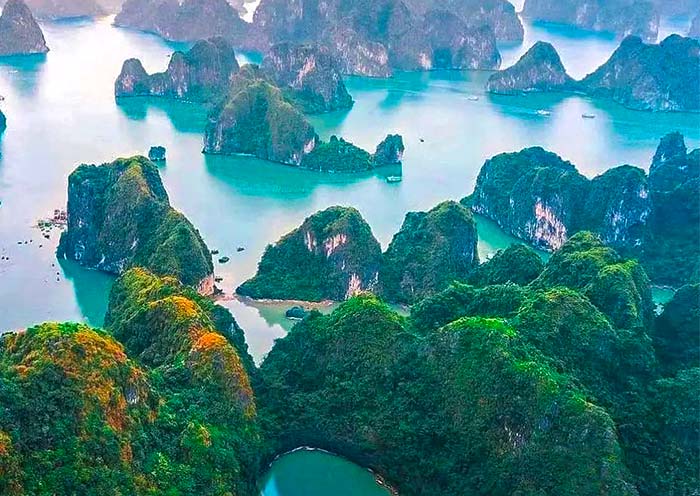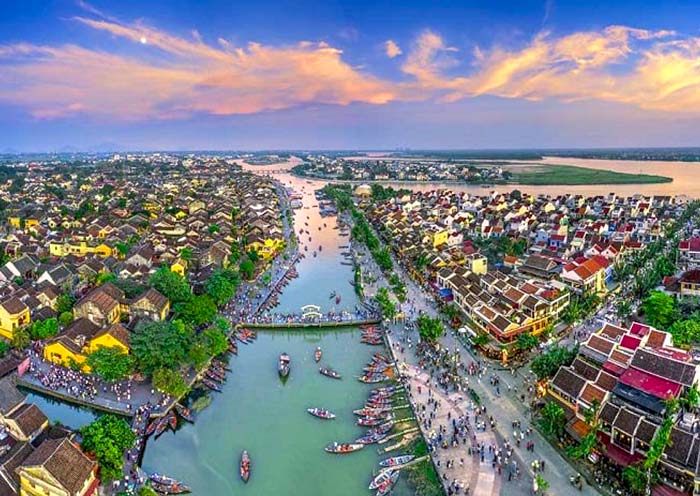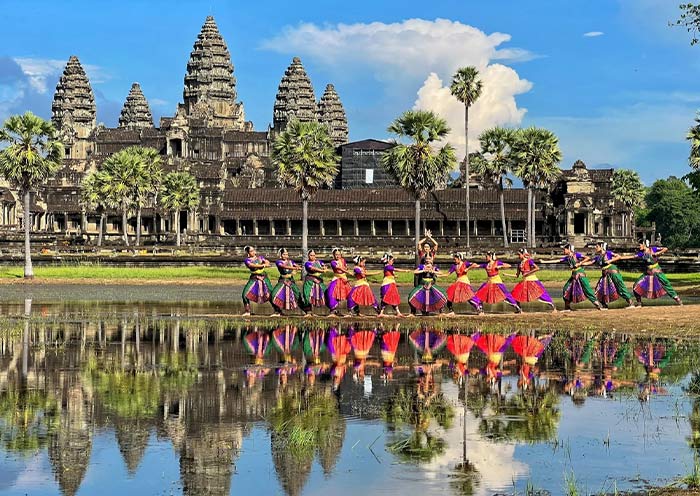10 Days Thailand Cambodia Highlights Tour: Phuket, Chiang Mai, Bangkok, Siem Reap
- Highlights
- Itinerary
- Price
- Trip Notes
- Accommodation
- Photos
- Reviews
Highlights of Thailand & Cambodia: Beaches, Elephants & Temples
Ever dreamed of exploring Southeast Asia? Thailand and Cambodia are undoubtedly the best starting points. This 10-day Thailand and Cambodia tour is specially crafted for first-time visitors who want to immerse themselves in the region's key destinations: Phuket, Chiang Mai, Bangkok, and Siem Reap, along with iconic attractions of Thailand and Cambodia like beautiful beaches, majestic elephants, and ancient temples.
Start your journey with the sun-kissed beaches of Phuket. Explore the iconic Phi Phi Islands, where crystal-clear waters and spectacular marine life create the perfect setting for snorkeling, swimming, and relaxation. Fly north to Chiang Mai, Thailand’s northern capital, where ancient temples meet modernity. Visit the historic Old City, Tha Phae Gate, Wat Phra Singh, and Wat Chedi Luang. Experience a meaningful encounter with Thailand's revered elephants at an ethical sanctuary, learning about their care and conservation.
Journey to the bustling city of Bangkok. Your tour will guide you through the most illustrious sites including the Grand Palace, Wat Phra Kaew, Wat Pho, and Wat Traimit. Stroll through the vibrant streets of Chinatown and witness a breathtaking sunset at Wat Arun by the riverside. Conclude your tour in Siem Reap, Cambodia, home to the awe-inspiring Angkor Wat complex. Watch the sun rise over Angkor Wat, explore the ancient city of Angkor Thom, wander through the jungle-clad ruins of Ta Prohm, and enjoy sunset views from Phnom Bakheng.
Are you ready to embark on this incredible journey? Let’s turn your dream of exploring Southeast Asia into a reality. Book now and let the adventure begin!
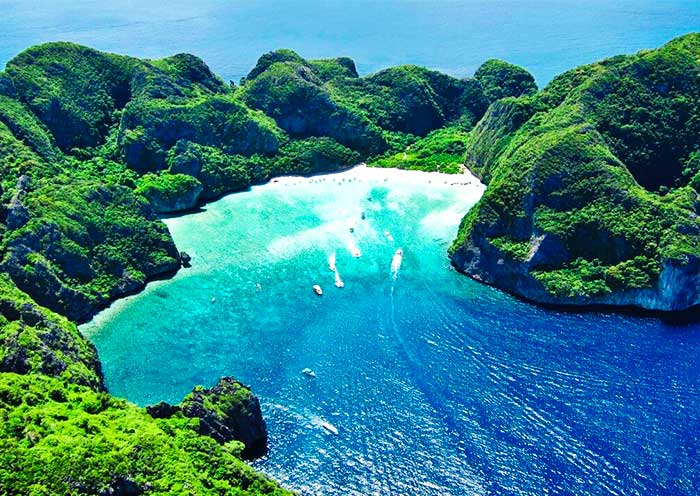

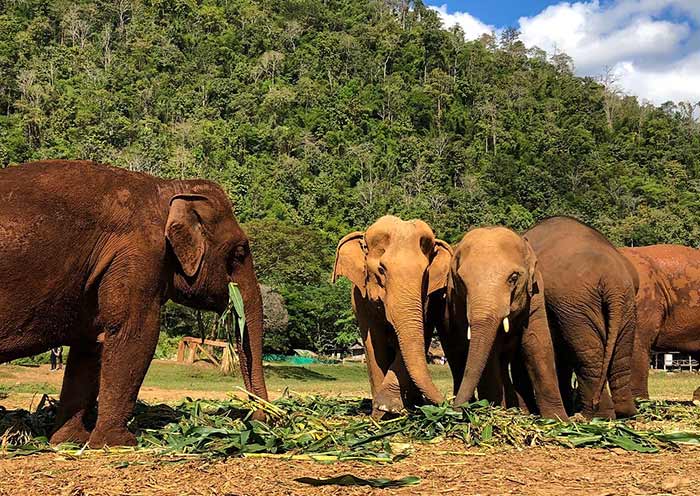


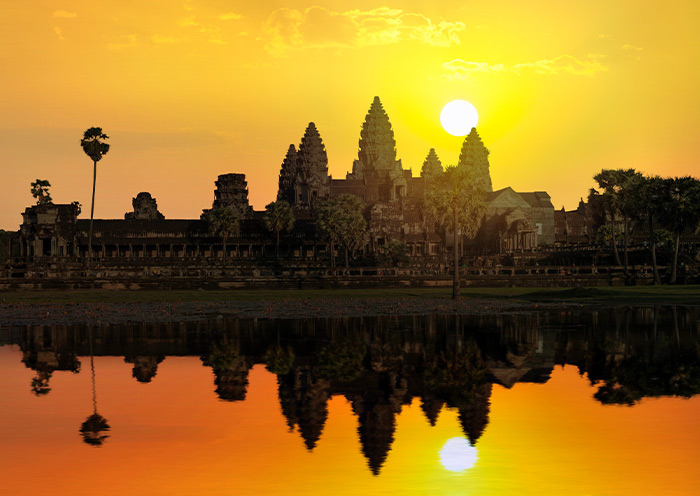
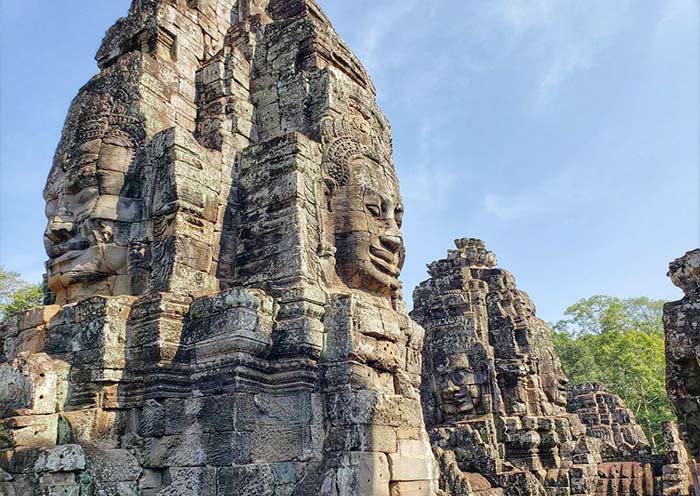

Itinerary at a Glance
Phuket (3 Days)
Free Time on The Beach, Phuket Island Hopping
Chiang Mai (2 Days)
Elephant Nature Park or Elephant Jungle Sanctuary, Chiang Mai Old City, Tha Phae Gate, Wat Phra Singh, Wat Chedi Luang
Bangkok (2 Days)
Wat Phra Kaew, Grand Palace, Wat Pho, Wat Traimit, Chinatown, Wat Arun.
Siem Reap (1 Day)
Floating Village, Tonle Sap Lake
Angkor Complex (1 Day)
Angkor Wat & Sunrise, Ta Prohm, Angkor Thom, Phnom Bakheng & Sunset
Siem Reap (1 Day)
Airport drop-off
Itinerary Day by Day
Welcome to Phuket, the largest island in Thailand and a premier beach destination in Southeast Asia! Upon your arrival at Phuket International Airport, our local guide and driver will greet you warmly. We will then escort you to your carefully chosen hotel in Phuket. Our team will assist you with the hotel check-in process, ensuring a smooth and comfortable start to your journey.
Phuket is celebrated for its stunning beaches, vibrant nightlife, and rich cultural heritage. With influences from Chinese and Portuguese traders, the island boasts a unique architectural and cultural blend. Phuket is also a paradise for food lovers, offering an exciting mix of Thai and international cuisines, with plenty of fresh seafood.
After settling into your hotel, the rest of the day is yours to explore at your own pace. You might want to unwind on the sandy shores, wander around the lively streets, or indulge in some local dishes.
Phuket Arrival Information & Transfer Info:
Flights to Phuket: Phuket is easily accessible by air, with direct flights from major cities in Southeast Asia such as Bangkok, Singapore, Kuala Lumpur, and Hong Kong, as well as long-haul connections from hubs like Dubai, Sydney, and Shanghai. Domestic flights within Thailand connect Phuket with Bangkok, Chiang Mai, and other cities.
Phuket Airport: Phuket International Airport is located approximately 30-45 minutes from most major areas on the island, including Patong Beach and Phuket Town.
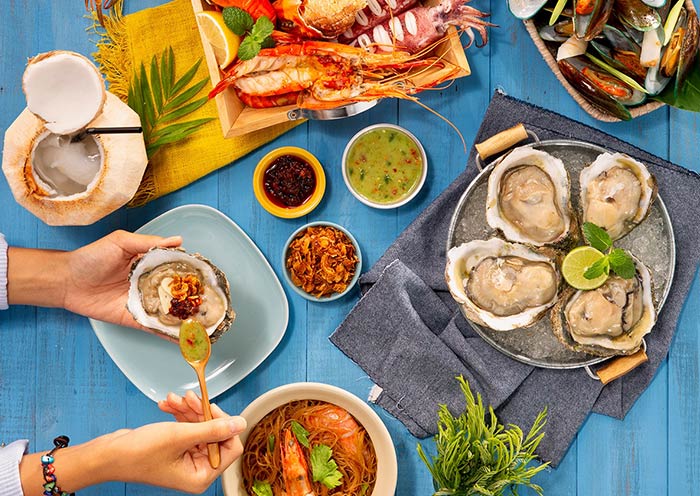
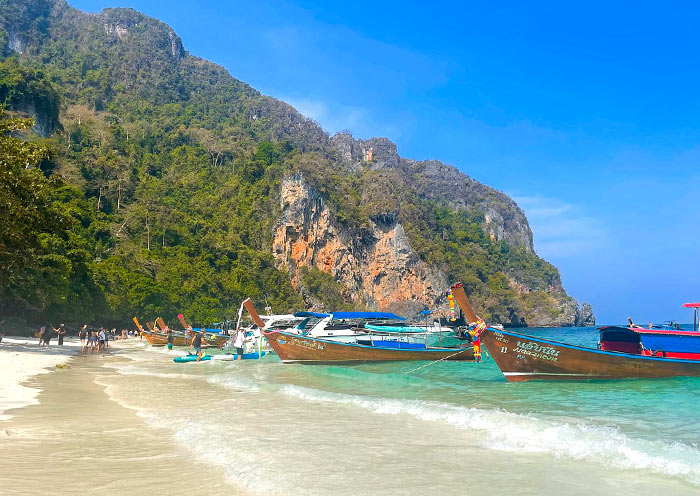
Today is the perfect opportunity for a family day trip to Phi Phi Island from Phuket. With its breathtaking scenery, diverse wildlife, and a wide range of relaxation and adventure activities, Phi Phi Island is a must-visit destination for any traveler in Thailand.
Renowned for its striking limestone cliffs, picturesque beaches, and pristine waters, the Phi Phi Islands consist of two main islands: Phi Phi Don (larger) and Phi Phi Leh (smaller). Day tours from Phuket often include visits to various islands, allowing ample opportunities for swimming, sunbathing, snorkeling, and island exploration.
You won't miss the Maya Bay (no swimming), a world-famous beach, made iconic by the movie "The Beach," which boasts stunning turquoise waters, limestone cliffs, and a beautiful crescent-shaped bay. You will have the chance to discover Pileh Lagoon, nestled amidst towering limestone cliffs and accessible only by boat. Take a refreshing dip in the emerald-green waters or explore the surrounding caves. Another notable site is the Viking Cave, home to colorful swallows and captivating rock paintings. When visiting Monkey Beach, observe the long-tailed macaques from a distance and keep an eye on your belongings, as these mischievous creatures are known to be curious.
Numerous snorkeling spots await you, teeming with marine life such as clownfish (Nemo), baby sharks (Maya Bay), turtles, coral reefs, and various other underwater creatures.
Warm Tips:
1.Choose the right tour: There are multiple Phi Phi Island day tours available from Phuket, so select one that aligns with your interests and budget.
2.Book in advance: Phi Phi Island is a popular tourist destination, especially from November to April, so it's advisable to book your day tour ahead of time.
3.Pack appropriately: Bring a swimsuit, beach towel, sunscreen, hat, sunglasses, comfortable clothing, and cash for souvenirs and snacks (not all tours include everything).
4.Consider seasickness medication: If you're prone to seasickness, it may be beneficial to bring appropriate medication, as the boat ride can sometimes be choppy.
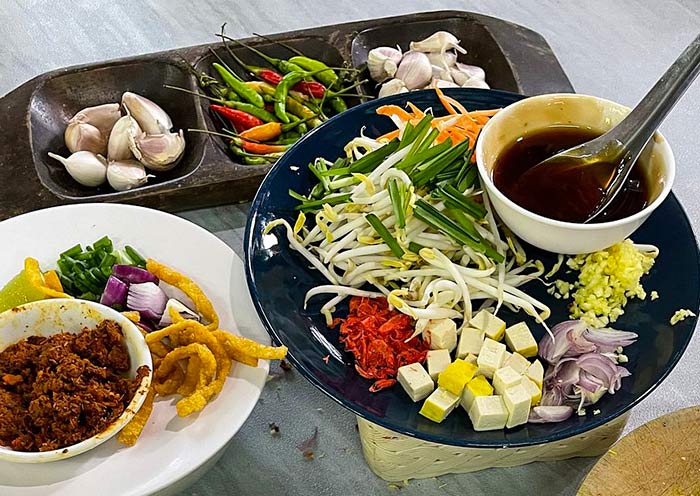


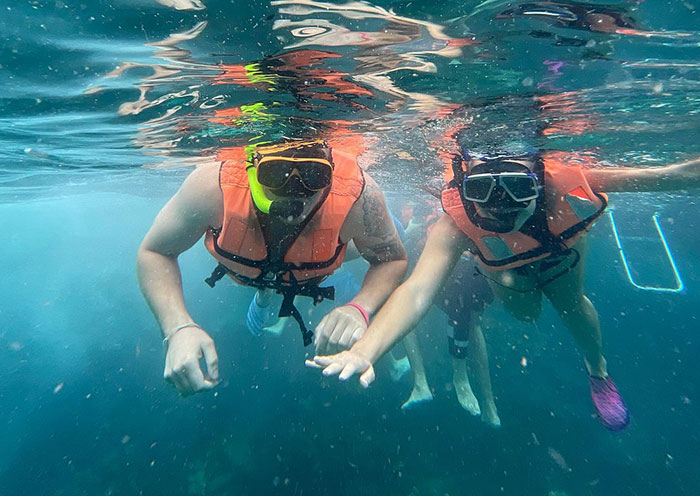
Leisure time by the beach in your hotel of Phuket. You can choose the hotel near Patong Beach, Kata Beach, Karon Beach, or other beach you like, to enjoy your relaxing days.
For the Party Gor, you can choose Patong Beach for water sports, exploring nightlife, shopping sprees, and day trips to nearby islands. You would love the energetic atmosphere, vibrant nightlife on Bangla Road, diverse restaurants and bars, and a wide range of shopping options including malls and markets. However, it can get crowded, especially during peak season.
For the Family Getaway, you can choose Kata Beach for water sports such as kayaking and paddle boarding, exploring viewpoints, visiting Kata Night Market for a local experience, taking cooking classes, and going on day trips to islands. You would love the calm waters and shallow areas, which are perfect for families with young children (specifically Kata Noi), the good selection of resorts and hotels, and the lively yet manageable nightlife at Kata Yai. However, it may be slightly more expensive than Karon Beach.
For the Relaxation Seeker, you can choose Karon Beach to relax on the beach, explore the underwater world, try surfing during the low season, take cooking classes, visit nearby temples like Wat Chalong, indulge in spa treatments, and explore Karon Night Market. You would love the laid-back atmosphere, spacious beach with soft sand, excellent snorkeling and diving at the southern end, a variety of water sports, and family-friendly activities like Dino Park Mini Golf. However, the nightlife options are limited compared to Patong, and it may not be the most luxurious choice.
Free Time Ideas:
For Island Hopping Adventures: Phuket is a great jumping-off point for exploring other stunning islands in the region. You can take a day trip to the Phi Phi Islands (optional, Phuket - Phi Phi Island - Phuket), famous for the movie "The Beach," or a day trip to the James Bond Island (optional, Phuket - 007 Island - Phuket)
For the one who seeking a unique blend of food, culture, history, and charm, it is a must to take a half-day Foodie tour to Phuket Old Town (optional).
You can choose to enjoy a half-day Phuket Elephant Sanctuary Tour (optional) if you are an Elephant fan.

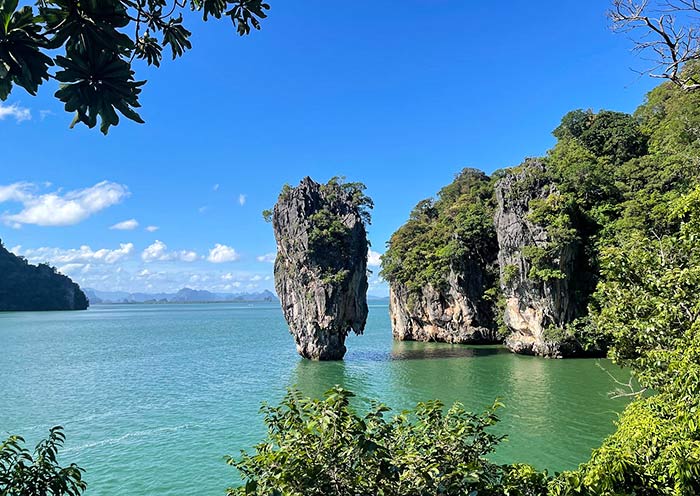
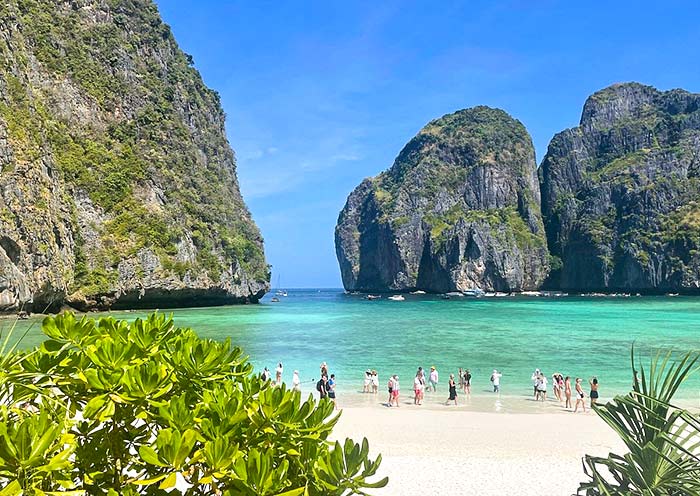
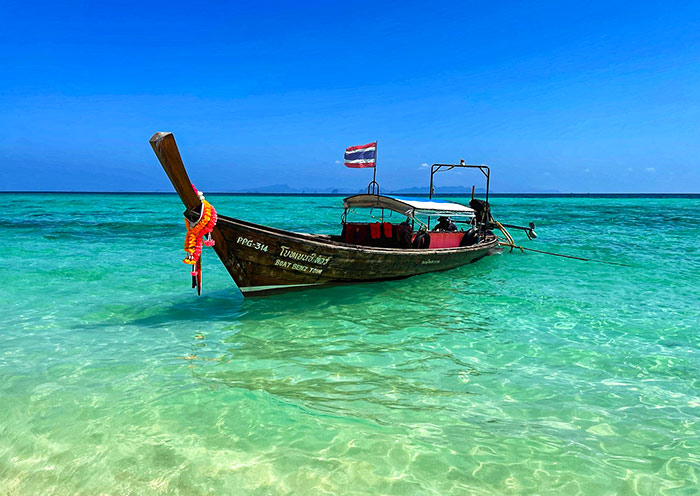
Today, you will take an early flight from Phuket to Chiang Mai, a journey of about two hours, to explore the Old City of Chiang Mai.
Chiang Mai is the second largest city in Thailand and was the capital of the independent Lanna Kingdom until 1558, the first kingdom in Thai history. It is renowned for its rich history, numerous temples, and unique culture. Chiang Mai is also known as the "Rose of the North" and offers a slower pace of life. People from all over the world flood here to get close to elephants through various Elephant Sanctuaries, experience local life through Thai Cooking Classes, and enjoy a vibrant atmosphere through its Walking Street Market and Night Bazaars around Chiang Mai Old City.
Famed as "The Rose of the North" which perfectly captures the city's charm and beauty. You can spend Half day Citywalk in Chiang Mai Old City to explore Chiang Mai’s stunning Temples (Wat Phra Singh, Wat Chedi Luang, Wat Phan Tao), vibrant culture, and a laid-back atmosphere. It's a place for Architecture and culture lover. After your Chiang Mai trip, you may understand why Chiang Mai was Teresa Teng's (邓丽君) favorite city.
In the morning, you will enter Chiang Mai Old City by the Tha Phae Gate, which is the landmark of Chiang Mai. The Old City is a square measuring 1.5 kilometers in length and 1.5 kilometers in width, surrounded by a moat. It is the most complete and well-preserved city gate, constructed in the early 13th century, remaining from the ancient walls that once surrounded the Old City. It served as a defensive structure against invaders and a gateway to the Lanna Kingdom. The area around the gate is always bustling with activity, especially during festivals like Loy Krathong and Yee Peng Lantern Festival (Sky Lantern Festival; Nov. or Dec.).
There are around 30 temples within the Chiang Mai Old City walls today. You will visit Wat Phra Singh, one of the three major temples in Chiang Mai, is the largest and most revered temple in the ancient city. It was originally built in 1345 when the fifth king of the Mangrai dynasty constructed a stupa to enshrine his father's ashes. Over time, it was expanded to its present scale. The temple, named after a famous Buddha image called Phra Singh (Lion Buddha), showcases stunning Lanna architecture, a unique blend of Thai, Burmese, and Mon styles. In the center of the temple stands a large golden pagoda, approximately 20 meters high, built in the 16th century, which is said to house the relics of Gautama Buddha. Wat Phra Singh is also one of the main locations for locals to celebrate the Songkran Festival (held annually from April 13th to 15th, Thai New Year).
Then, visit Wat Chedi Luang (Temple of the Big Stupa) which was located at the center of Chiang Mai Old City. The temple has a history of over 600 years and holds the same esteemed status as Wat Phra Singh, making it one of the three major temples in Chiang Mai. The centerpiece of the temple is the Lanna-style square-shaped great stupa, originally standing at a height of 98 meters, which was once the tallest structure in northern Thailand. It was built by King Saen Muang Ma of the Lanna Kingdom in 1411 AD. Throughout history, it has endured wars, and earthquakes, leaving only the 42-meter-high base and the ground level, bearing witness to the storied and profound history of Chiang Mai. Currently, new Buddha images have been placed on the four sides of the great stupa. On the southern wall, there are six elephant sculptures, with five of them being replicas restored with cement, and only the rightmost one being the original piece that has been preserved. It is worth seeing.
Later, hop to Wat Pun Tao which is 100 meters away from Wat Chedi Luang. Wat Phan Tao, also known as the Teakwood Temple, is entirely constructed from teakwood provided by the royal family. With a pure Lanna-style design, built in the late 1870s, making it a treasured sanctuary within the city of Chiang Mai. It is also one of the few remaining wooden structures in the area. Every year during the Yi Peng Lantern Festival (mid Nov., Thai Lantern Making & Releasing), Wat Phan Tao holds a lighting ceremony, attracting photographers from both domestic and international locations.
If time permit, you can visit Wat Chiang Man, the oldest temple in Chiang Mai. It is the first Buddhist temple in the ancient city and was personally supervised and built by King Mengrai, the first king of the Lanna Kingdom, in 1297.
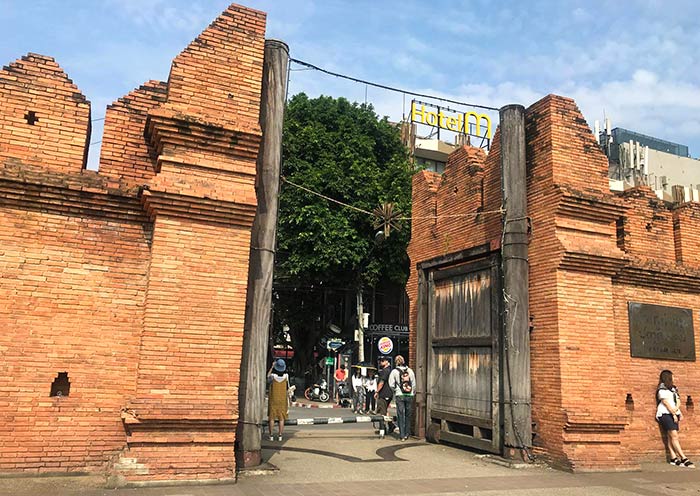



Chiang Mai is a popular destination to see elephants up close in a wide open space. Today, you will enjoy a half-day morning visit to Elephant Nature Park (9:30 am to 1:00 pm), which is approximately 50km away from Chiang Mai Old City, requiring a 1.5-hour drive. Afterward, you can freely relax for the rest of the day, perhaps by taking a Chiang Mai Cooking Class (15:30-19:00; optional) or trying out Lila Thai Massage near the Tha Pae Gate (optional). This offers a delightful opportunity to experience the real local life in Chiang Mai.
Thailand is known as the "Land of the White Elephant". Although actual white elephants do not exist in Thailand, Asian elephants do. Elephants are deeply woven into Thai mythology and religious stories for their strength and intelligence. According to legend, on the eve of Buddha's birth, his mother dreamt of a white elephant approaching her and offering a lotus flower. Since then, white elephants have been considered sacred by the Thai people, symbolizing wealth, peace, and prosperity. Throughout history, Thai people have had a close relationship with elephants, utilizing them as warriors on the battlefield and as beasts of burden for transporting agricultural goods and logs from the forest. Nowadays, numerous elephant sanctuaries offer Eco-tourism experiences throughout Thailand. As the national animal of Thailand, there is still much work to be done to ensure the well-being and future of elephants.
Elephant Nature Park (ENP), established on the edge of a rainforest near Chiang Mai in 2003, is one of the leading ethical elephant sanctuaries and a pioneer in prioritizing the well-being of elephants. With over 130 elephants roaming freely within its premises, ENP provides a natural environment, proper care, and a chance for rescued elephants to recover from past abuse. During your visit, you will have an unforgettable experience with elephants, as well as other rescued animals such as buffaloes, dogs, cats, horses, goats, and birds. Accompanied by a guide, you will learn about how the cost of your ticket contributes to the elephants' well-being, including the purchase of their food: corn stalks, sugarcane, watermelon, and bananas. It's fascinating to note that an adult elephant consumes 200-400 kilograms of food per day! You will also have the opportunity to learn more about the founder, Lek, the daily lives of the elephants, the unique stories of each elephant, and how elephants bathe themselves. While keeping a certain distance (hands off; Let Elephants be Elephant is), you can enjoy the company of these majestic and wise creatures and witness their happiness as they now live freely in a peaceful and natural environment where they are loved and respected.
After a Vegetarian lunch in the park, head back to your hotel and enjoy your relaxing day freely. Overnight in Chiang Mai.
Free Time Idea around Chiang Mai Old City:
Half-day Thai Cooking Class in Chiang Mai: There are many Chiang Mai Cooking Schools that offer various Cooking Classes (appetizer, stir-fry, dish, soup, curry, dessert), from farm to table or from market to table, enjoy the famous Thai Dishes cooked by yourself (Thai tea, Tom Yam Soup, Pad Thai and more).
Try Chiang Mai Women's Correctional Institution Lila Thai Massage (Optional, self-pay). It is located near the Tha Pae Gate.
Foodie Experiences in Chiang Mai: Explore local markets around the Chiang Mai Ancient City such as Warorot Market (Everyday: 4am-6pm), Jing Jai Market (Everyday: 8:30am-9pm), Coconut Market (Saturday/Sunday/Monday, 8am-2pm), White Marke (Nimmanhaemin Road; 3pm-10pm; Closed on Weds & Thur.). Do double-check with your local guide for the market opening time.
Chiang Mai Night Safari (evening optional) is a must-visit for all nature and animal enthusiasts and kids.
Warm Tips:
There are many Elephant Sanctuaries in Chiang Mai, if Elephant Nature Park (Hands-off) is not available during the high season, or you prefer more activities with elephants, you can also choose Elephant Jungle Sanctuary.
It is optional to do a full-day tour of Elephant Nature Park (9:30 am - 3:30 pm; return to Chiang Mai City at 4:30pm-5:00pm) if you are an Elephant fan and would like to skip the Thai Cooking Experience.3. If you are interested in local markets or Night Bazaars, be sure to note that some markets are only open on Saturday or Sunday. Ask your guide for advice.

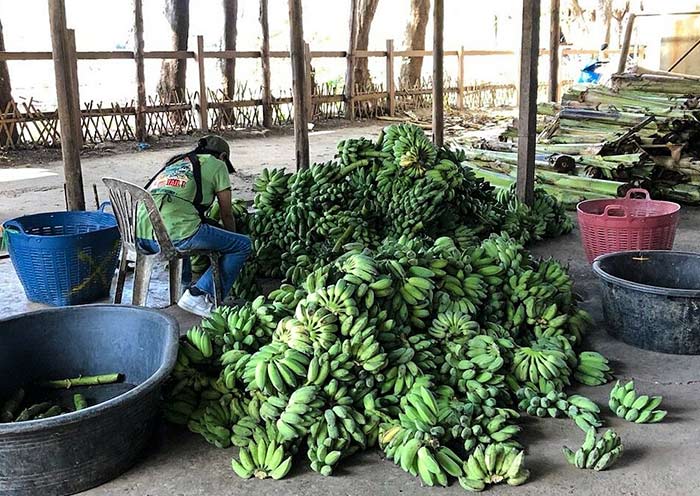

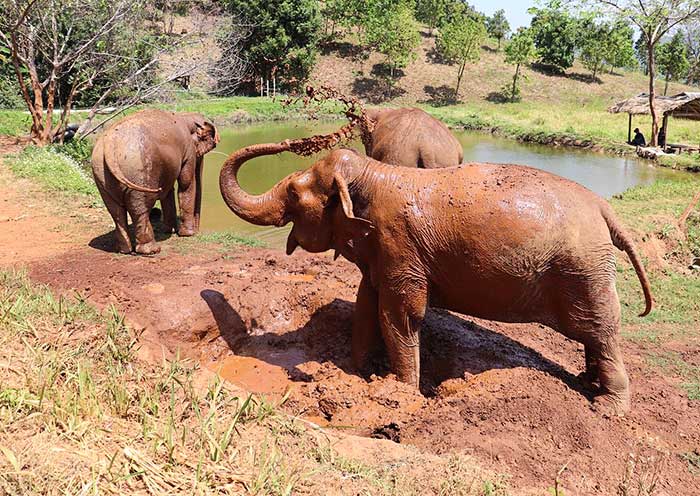
Today is free for you until you are transferred to Chiang Mai airport for a flight to Bangkok, which takes about 1 hour and 20 minutes. Upon your arrival at the airport in Bangkok, the tour guide and driver will meet you at the exit and then escort you to the hotel in downtown Bangkok. You can have a good rest in your hotel and get ready to explore Bangkok with your guide the next day.
Bangkok means the "City of Angels" in translation from its ceremonial Thai name, Krung Thep Maha Nakhon. It is a vibrant metropolis known for its bustling markets, ornate temples, and delicious Thailand street food. You can indulge in Bangkok's diverse culinary scene, from street eats to upscale dining. Shop till you drop in luxury malls or explore local markets. Enjoy the city's lively nightlife, rooftop bars, and live music venues. Bangkok offers a blend of tradition and modernity, making it an exciting and captivating destination.
Free Time Ideas:
You can watch a Thailand boxing game at Rajadamnern Stadium.
Unwind with a traditional Thai massage or spa treatment.
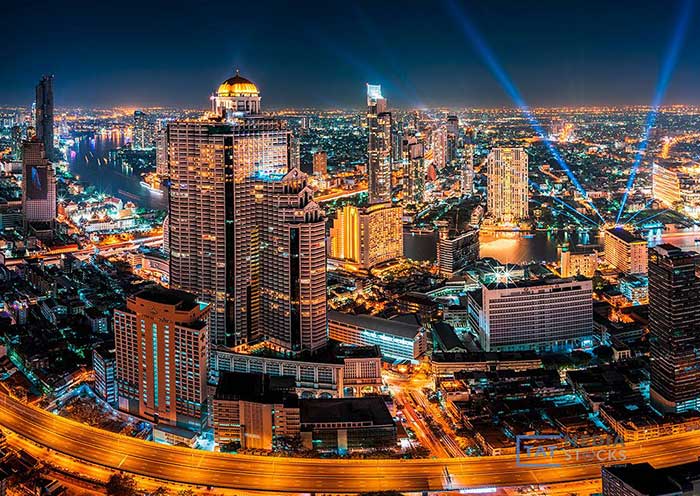

Today, you will explore the Top 6 must-visit places in Bangkok: Wat Phra Kaew, Grand Palace, Wat Pho, Chinatown, Wat Traimit, and Wat Arun. You see “Wat” means “Temple” in Thai language. You will also experience a Thai tuk-tuk, take a ferry or boat ride on the Chao Phraya River, and indulge in local food in Chinatown. This is a classic Bangkok trip, allowing you to witness 3 treasures of Thailand: the jade Buddha, the reclining Buddha, and the golden Buddha.
In the morning, head to Wat Phra Kaew which was built in 1782 and is located in the northeast corner of the Grand Palace in Bangkok. Covering one-fourth of the Grand Palace's area, Wat Phra Kaew is the most famous royal Buddhist temple in Thailand. This temple is renowned for enshrining one of three national treasures of Thailand, the Emerald Buddha, which is carved from a single block of Emerald. Each year, the Thailand King personally changes the Buddha's robes according to Thailand's three unique seasons. Each season changes with a certain robe: a gold robe embedded with rubies for the hot season, a gold robe embedded with sapphires for the rainy season, and a pure gold robe for the cool season. Don’t forget to check which robe the Emerald Buddha wears when you are there.
On the walls surrounding the cloisters of Wat Phra Kaew, there are a total of 178 murals (1,000m in length). Painted during the reign of King Rama I, the first monarch of the Chakri Dynasty in 18th-century Thailand (Bangkok Dynasty), the murals depict scenes from the Indian mythological epic "Ramayana," which narrates the story of King Rama joining forces with the monkey deity Hanuman to defeat the demon king Ravana and rescue the exquisite princess Sita. It is said that the story of the "Journey to the West" is also based on this legend. All the murals were created by royal court painters and the golden pigments used were made entirely from gold, resulting in exquisite and unparalleled artwork.
With the guidance of your tour guide, you can learn about the mythical creatures within Thai Buddhist architecture. For example, there is the Garuda, a mythical bird and guardian deity of Buddhism, perched on the rooftops. At the entrance of the temple, you'll find Yaksa, a protective deity, and outside the halls, there are statues of Kinaree, a mythical half-bird, half-human creature. The base of the pagoda is adorned with statues of Hanuman, the monkey deity.
After visiting Wat Phra Kaew, you can go on a visit around the Grand Palace. The Grand Palace, which was first established in 1782, was constructed as a replica of the old palace in the former capital city of Ayutthaya. It serves as a symbol of the Bangkok Dynasty and is the most well-preserved, largest, and most distinctive palace in Thailand. The Grand Palace is currently used for coronation ceremonies, royal celebrations, and hosting foreign dignitaries. From King Rama I to King Rama VIII, all the monarchs of the Bangkok Dynasty resided in the Grand Palace. However, after an assassination incident in 1946 involving King Rama VIII, King Rama IX moved to a new residence. The Bangkok Dynasty has continued to the present day, with the current monarch being King Rama X.
The Grand Palace complex consists of 22 buildings and is elegantly situated along the banks of the Chao Phraya River. The main structures are four distinct palaces (Borombhiman Hall, Amarindra Hall, Chakri Mahaprasat, Dusit Hall), showcasing the essence of Thai architecture, painting, sculpture, and interior decoration. It is often referred to as the "Encyclopedia of Thai Art". By the way, the Thai King is considered the incarnation of the god Vishnu, and Garuda is Vishnu's guardian. As a result, sculptures of the Garuda (stepping on 2 serpents) can be found on door lintels, eaves, and walls, with a total count exceeding several hundred. Witnessing the changing of the guards' ceremony is a bonus when visiting the Grand Palace.
Then, visit Wat Pho (Temple of the Reclining Buddha) which is a 10-minute walk from the Grand Palace. As the oldest and largest temple in Bangkok, Wat Pho houses the largest reclining Buddha and the highest number of Buddha images and stupas in the city. The reclining Buddha, one of three national treasures of Thailand, is 46 meters tall and 108 meters long, depicting the scene of the Nirvana of Gautama Buddha. Within the temple grounds, there is a Bodhi tree, believed to be the spot where the Buddha meditated. The temple is adorned with about 100 stupas, with the most magnificent being the four stupas which are decorated with blue, white, yellow, and green ceramic tiles. In the courtyard, you can also see many Chinese-style stone sculptures, such as door guardians and lions, which were traditionally used on ships for ballast and protection against evil spirits.
Wat Pho is regarded as Thailand's first university and is considered the birthplace of Thai medicine and traditional Thai massage. It still houses a private school established in 1957 that teaches traditional Thai medicine and offers authentic Thai massages (optional, self-pay).
Head to Chinatown Bangkok for lunch. Chinatown Bangkok (Yaowarat) is renowned as one of Bangkok's liveliest and most bustling commercial areas, with reportedly 70% of the city's gold shops located in Chinatown. It is also home to Wat Traimit, the world's largest solid gold Buddha statue. The entire street of Chinatown stretches for about 2 km, lined with numerous shops, and thousands of businesses proudly displaying eye-catching Chinese signs. You may have watched the film Detective Chinatown, which was filmed in Chinatown Bangkok which has a history of over 200 years. You can search for the hidden shops that appeared in the film while enjoying the food in Chinatown, a haven for foodies. The restaurants and food stalls here provide a rich selection of Chinese, Thai, and other Asian delicacies. From classic pad thai to exotic grilled meats, there's something for everyone.
After lunch, visit Wat Traimit (Temple of the Golden Buddha). Built in 1785, it is renowned for housing the world's largest gold Buddha. The gold Buddha (one of three national treasures of Thailand) inside the temple weighs 5.5 tons and stands at a height of 3 meters. It was constructed with the contributions of 3 Chinese individuals, hence it is also known as the Three Chinese Temple or Three Friends Temple. The royal family holds annual ceremonies here to welcome the New Year. Unlike other temples, photography is allowed inside the temple hall in designated areas(video recording is not permitted). From fourth floor of the Wat Traimit, you can enjoy a distant view of the tallest building in Thailand (314m), the King Power Mahanakhon (Pixel Tower).
In the afternoon, take a tuk-tuk ride to the pier via a quick stop at Pak Khlong Talat Flower Market, also known as Bangkok Flower Market, which is one of the top 9 flower markets in the world. Then, take a ferry or boat (cruise; optional) on the Chao Phraya River to view Wat Arun (outside view). The Chao Phraya River divides Bangkok into two parts, and many famous temples are concentrated along its banks. The Wat Arun, is one of the most prominent temples that stands on the river's edge, complementing the Grand Palace on the opposite side. (Note: Due to the hot weather and the presence of numerous steps at Wat Arun, many of our guests opt to take a boat trip and enjoy the view of Wat Arun from the outside, either from the boat itself or from the opposite side.)
Built in 1809, Wat Arun was established to honor King Taksin (郑信), the 41st monarch of Thailand (1767-1782) and a national hero. During the invasion of the Burmese army, King Taksin led the Thai people in a brave resistance, successfully driving out the Burmese and establishing the Thonburi Kingdom. To commemorate this Chinese-Thai king (from Guangdong), the temple was named Wat Arun, meaning "Temple of Dawn", as the battle took place at dawn. The main stupa of the temple stands at a height of 79 meters and is often referred to as the Thai version of the Eiffel Tower. In contrast to many other magnificent temples adorned with gold, Wat Arun stands out with its elegant white structure, attracting numerous visitors who come to rent traditional Thai costumes for photography. Situated by the Chao Phraya River, Wat Arun (Temple of Dawn) also offers a captivating view of the sunset, which is another reason why people flock to this location.
After that, you can enjoy your free time such as paying a visit to the Khao San Road for the night markets that offer a dazzling array of street food, souvenirs, and clothing.
Warm Tips:
- When entering the Grand Palace or temples, it is prohibited to wear shorts or skirts that do not cover the knees. Shoulders and midriffs should be covered, and clothing should not be excessively tight or have holes.
2.Upon entering a temple, remove your hat and shoes. Photography is prohibited inside the temple halls. The use of drones is strictly prohibited within the royal grounds.
Do not enter unauthorized areas or areas marked with warning signs. Unauthorized photography or videography is prohibited in restricted areas.
The lights of Wat Arun usually turn on around 7 PM. For sunset, it is recommended to arrive Wat Arun around 5:30 PM, do double check with your guide for the sunset time based on your travel schedule. It is said that the best spot to capture the beauty of Wat Arun is in the alley across from Wat Pho, where a restaurant is located.
Opening Hours for Temples (Wat):
Wat Phra Kaew : 8:30 AM - 3:30 PM
Wat Pho: 8:00 AM - 6:30 PM
Wat Traimit: Thursday to Sunday, 8:00 AM - 5:00 PM
Wat Arun : 8:00 AM - 6:00 PM
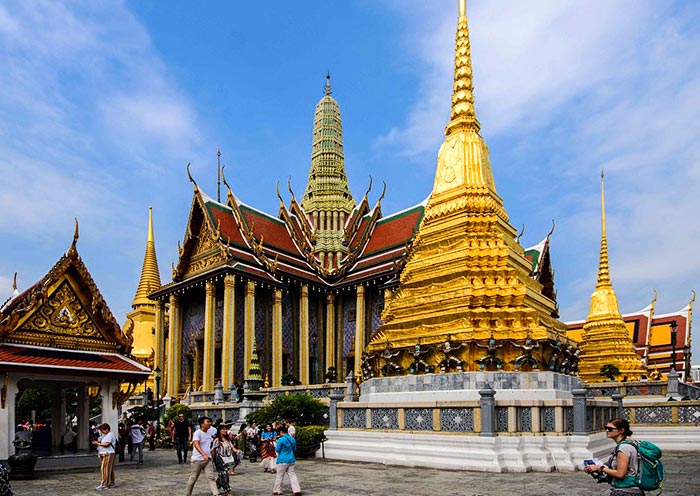
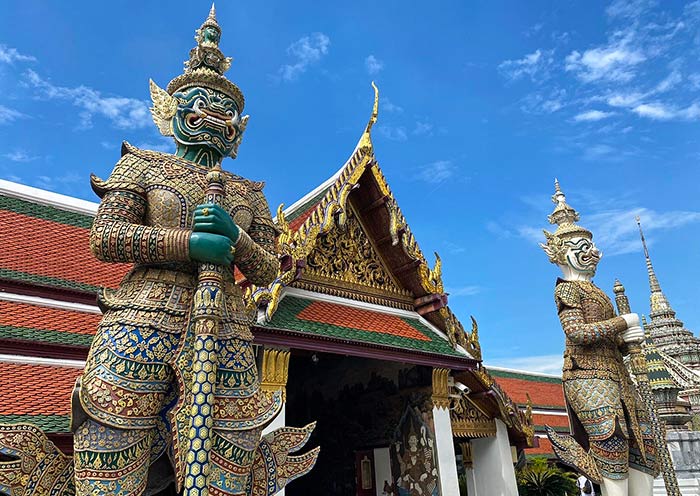
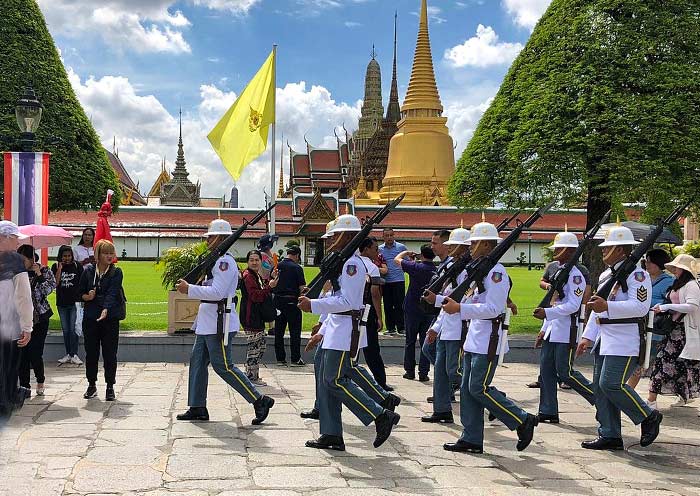

Today, you'll be driven to Bangkok Airport for your flight to Siem Reap, Cambodia.
Welcome to Siem Reap, your gateway for the Temples of Angkor. When you arrive at Siem Reap–Angkor International Airport (SAI), your tour guide and driver will meet you at the exit and then escort you to the hotel in downtown Siem Reap.
Siem Reap is a city in northwestern Cambodia, best known as the gateway to the Temples of Angkor, including the iconic Angkor Wat, which is just 6 kilometers away. The city has transformed into a major tourist hub, with a diverse range of accommodations, and bustling nightlife with numerous restaurants, bars, and night markets.
In the afternoon, you will travel to Tonle Sap Lake to visit the floating village of Kompong Khleang. Known as the largest freshwater lake in Southeast Asia, Tonle Sap is home to numerous floating villages. These are unique for their stilted houses, which are built on platforms supported by wooden poles or tethered to boats, adjusting to the lake's changing water levels. The villages also have floating schools, shops, and even churches.
Enjoy a boat ride (about 1.5 hours) to observe the residents' unique lifestyle and the region's rich biodiversity. If it happens to be dusk, you will appreciate the beautiful sunset on Tonle Sap Lake.
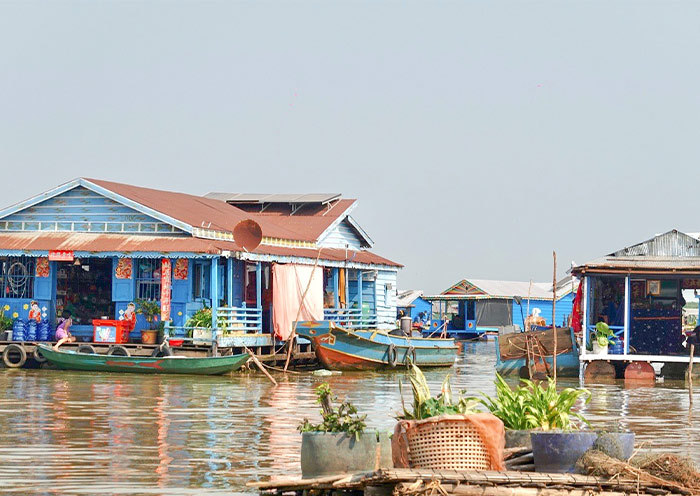
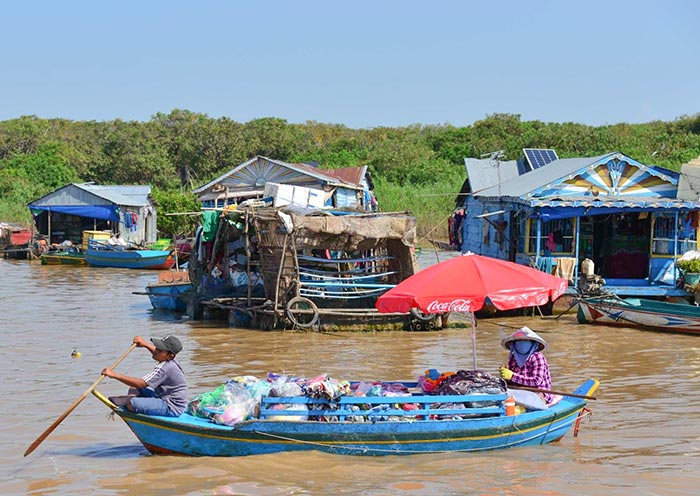
Designated as a UNESCO World Heritage site, Angkor Archaeological Park is a vast and impressive complex. It spans an area of roughly 400 square kilometers and contains the magnificent remains of the various capitals of the Khmer Empire, which flourished from the 9th to the 15th centuries.
Today, we will guide you through an exploration of some of the most iconic temples and structures within the park, including the majestic Angkor Wat and Angkor Thom complexes, and the enchanting Ta Prohm.
Scenic Spots You will Pass:
Sunrise → Angkor Thom → Ta Prohm → Angkor Wat → Phnom Bakheng Sunset → Get back to your Hotel
Start your day early with a sunrise viewing at Angkor Wat. Arrive at Angkor Wat in time to find a good spot to watch the sunrise. Tips: The sun rises between 5:30 AM and 6:30 AM, depending on the time of year. The silhouette of Angkor Wat’s iconic spires stands sharply against the lightening backdrop, creating a stunning contrast that slowly fills with color. The temple's vast moat reflects this magical scene, doubling the beauty in a perfect mirror image that enhances the surreal atmosphere. After the sunrise, head back to your hotel for breakfast and a short rest.
After breakfast, head to Angkor Thom, the last and most enduring capital city of the Khmer empire. It was established in the late 12th century by King Jayavarman VII in the late twelfth century. Angkor Thom means "Great City" in Khmer. Set over 10 square kilometers, the aptly named last great capital of the Khmer empire took monumental to a whole new level.
Enter through the South Gate and proceed to the Bayon Temple at the city's center. This temple is known for its numerous smiling faces carved into its towers. Each of its 54 Gothic towers is decorated with 216 gargantuan smiling faces of Avalokiteshvara. The temple also features 1.2km of extraordinary bas-reliefs, incorporating more than 11,000 figures. Take your time to marvel at these detailed bas-reliefs, which portray historical events and scenes from daily life in the empire. A short walk northwest from the Bayon will bring you to the Baphuon Temple. This temple, which predates Angkor Thom, was originally a Hindu temple dedicated to Shiva.
Next, visit the Terrace of the Elephants. King Jayavarman VII used this terrace as a viewing platform to observe his victorious returning army. You'll find it adorned with carvings of elephants and other animals, providing excellent photo opportunities. Continue to the nearby Terrace of the Leper King. This 7-meter high laterite platform features multiple tiers of meticulously carved walls depicting nagas (serpents), demons, and various mythical beings. Conclude your visit to Angkor Thom by exiting through the Victory Gate on the east side of the city.
Later, proceed to Ta Prohm (Jungle Temple). Its appeal lies in the fact that, unlike the other monuments of Angkor, it has been swallowed by the jungle, and looks very much the way most of the monuments of Angkor appeared when European explorers first stumbled upon them. It was also featured in the movies "Tomb Raider" and “Raiders of the Lost Ark”, which adds to its popularity. After exploring Ta Prohm, enjoy a relaxing lunch at one of the local restaurants nearby.
In the afternoon, return to Angkor Wat for a more detailed tour of this iconic temple. Uniquely designed with a westward orientation, Angkor Wat is best viewed in the afternoon light. Angkor Wat, the largest monument of the Angkor group and the best preserved, is an architectural masterpiece. Its perfection in composition, balance, proportions, relief, and sculpture make it one of the finest monuments in the world.
Angkor Wat is surrounded by a vast moat, 190 meters wide, forming a rectangle of 1.5 by 1.3 kilometers, which symbolizes the mythical oceans surrounding Mount Meru, the center of the universe in Hindu cosmology. Visitors can enter through the west-facing main gate, which leads directly into a long causeway lined with naga balustrades. Spend time in the galleries which feature extensive bas-reliefs depicting epic stories such as the Battle of Kurukshetra from the Mahabharata, the Judgment by Yama, the Hindu god of death, and scenes of heavenly nymphs (Apsaras) and everyday life in the Khmer Empire. At the heart of the temple complex is the central sanctuary surrounded by four smaller towers, forming a quincunx. The central sanctuary, rising majestically above the forested landscape, symbolizes the mythical Mount Meru and offers a unique perspective on the temple’s layout and the geometric precision with which it was built. Climb up to the central tower, a privilege that offers not only a closer view of the intricate lintel carvings and sculpted friezes but also panoramic views of the entire complex and its surroundings.
If you have enough energy, consider climbing up to Phnom Bakheng Hill to enjoy the sunset view. The climb takes about 15-20 minutes. Arrive early as this popular spot can get crowded at sunset. From here, watch the sky change colors over the main temples of Angkor and the surrounding forests - a perfect end to a day of exploration.
After the tour, drive back to your hotel. Stay overnight in Siem Reap.

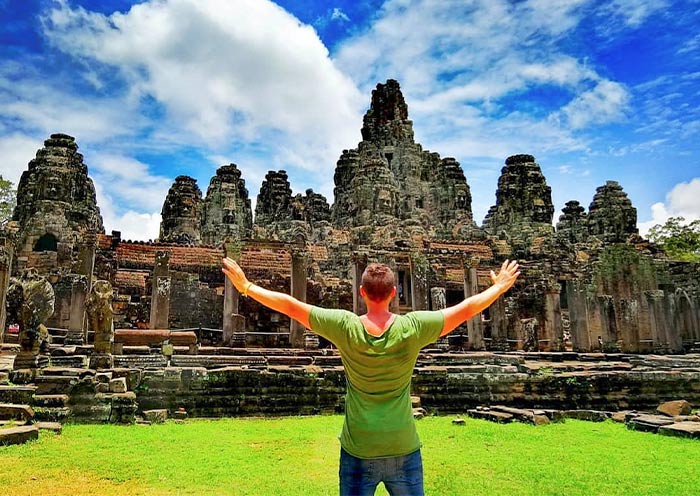
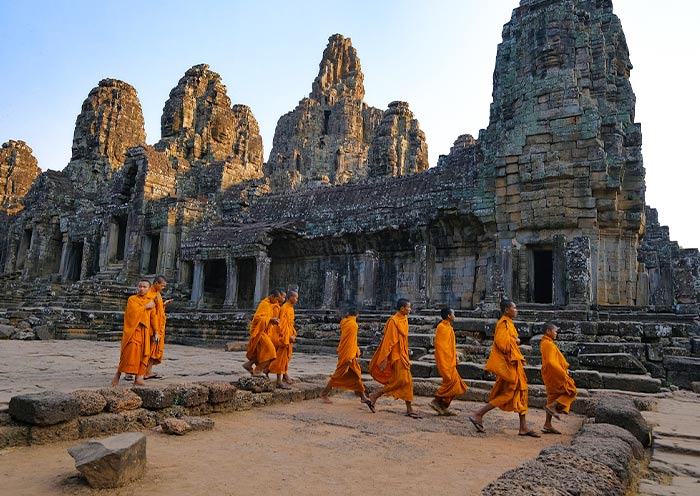
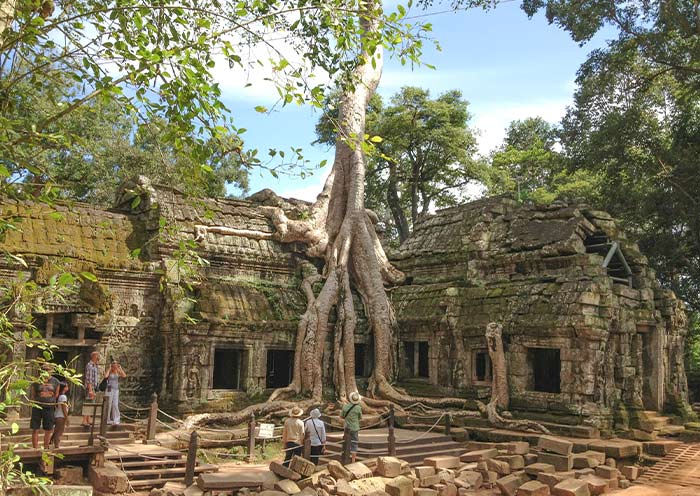
It is time to end your 10 Days Thailand Cambodia Tour. Today, you'll driven to Siem Reap–Angkor International Airport for your departure. The drive takes approximately an hour.
Trip Extension: If you prefer to travel longer in Southeast Asia you can extend your trip to neighboring countries such as Vietnam, Laos, etc.
Thank you for choosing Asia Odyssey Travel for your Asia tour, we are always here working for you and hope to see you again for your next trip to Asia. Safe journey!
Price: What’s Included & What’s Excluded
What's Included:
What's Excluded:
Important Travel Tips for Visiting Southeast Asia
Visa requirements vary depending on your nationality and the length of your stay. It's important to check the specific requirements for each country you plan to visit well in advance of your trip. You can usually find this information on the embassy or consulate website of the country you're visiting.
Dry season (November to April): This is the peak tourist season for Southeast Asia as a whole, with the most consistent sunshine and comfortable temperatures. Ideal for beach lovers and those who want to avoid the rain. This is also a great time for trekking and other outdoor activities.
Average temperatures during Dry Season in Southeast Asia:
- Vietnam: 77°F - 86°F (25°C - 30°C): It can be slightly cooler in the northern mountains during December and January.
- Thailand: 82°F - 90°F (28°C - 32°C): Eastern and southern Thailand, including popular beach destinations, tend to be a few degrees warmer than the north.
- Laos: 75°F - 88°F (24°C - 31°C): Keep in mind that the mountainous areas of Laos can get chilly at night, especially in December and January.
- Cambodia: 84°F - 93°F (29°C - 34°C): Temperatures can get quite hot, especially from March to May, in Siem Reap (Angkor Wat).
The currency varies from country to country. In Vietnam, the currency is the Vietnamese đồng (VND). In Thailand, it's the Thai baht (THB). In Laos, it's the Lao kip (LAK). And in Cambodia, it's the Cambodian riel (KHR). However, US dollars are widely accepted in most tourist areas.
- Dress modestly: When visiting temples, pagodas, or other religious sites, it's important to dress modestly and respectfully. This means covering your shoulders and knees.
- Removing shoes: In many temples, it is customary to remove your shoes before entering. Look for a pile of shoes at the entrance as a cue to do the same.
- Bargaining: Bargaining is a common practice in Southeast Asia countries’ markets and street stalls. However, it's important to do so respectfully and with a friendly attitude. Remember that the aim is to reach a mutually agreed-upon price, not to aggressively drive the price down.
Looking for more travel guides about Southeast Asia countries? Want to gather additional information to plan your trip? Our team of professional travel experts has written over 100 articles about Vietnam Thailand Cambodia Laos. Please check out our Southeast Asia Travel Guide for inspiration and detailed insights.
Hotel Conditions for Your Southeast Asia Tour
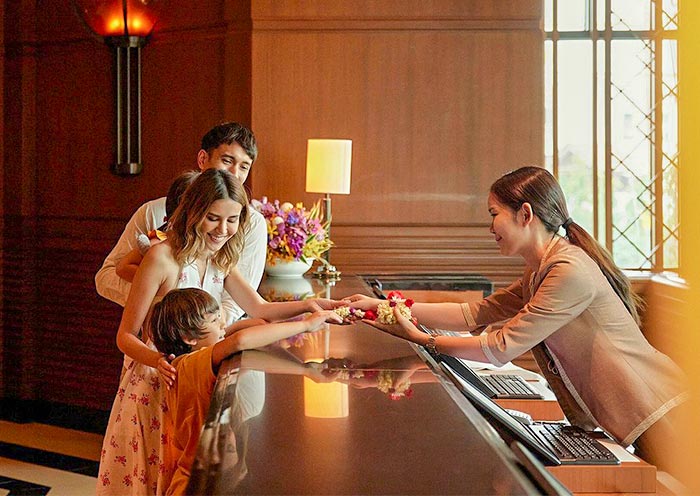

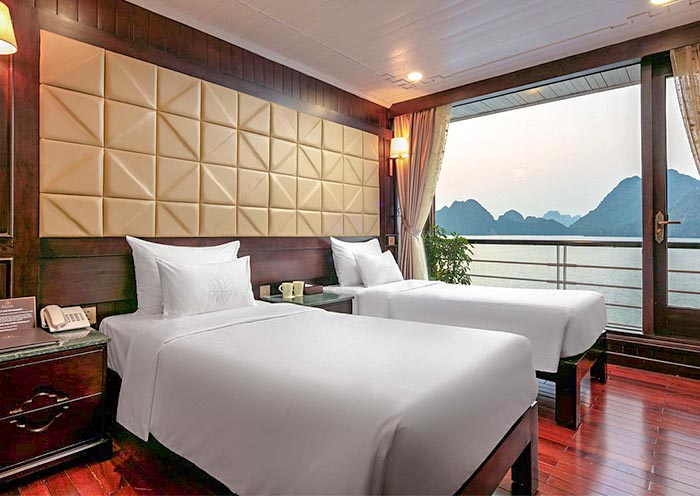
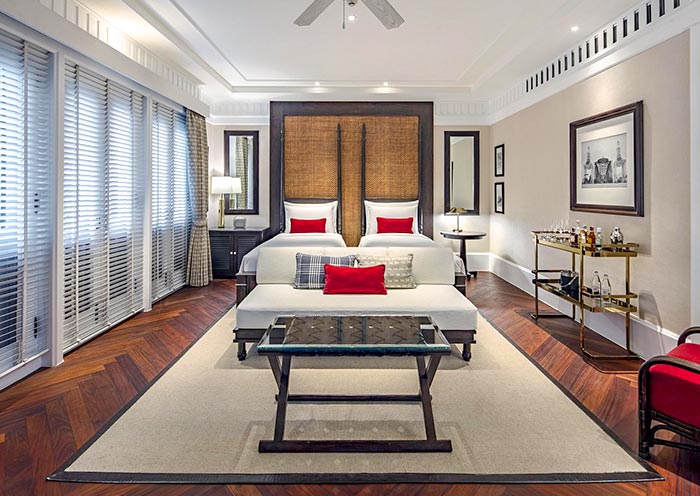
No matter whether you combine 2 or 3 countries, or visit all 4 countries in Southeast Asia, there are many different hotel styles and types to choose from. Travelers typically spend 7-9 nights in Vietnam, 6-9 nights in Thailand, and 2-3 nights each in Cambodia and Laos.
To cater to diverse traveler preferences and budgets, we offer a curated selection of accommodations. Our options include luxurious 5-star hotels, comfortable 4-star options, and economical 3-star establishments. All our selected hotels are conveniently located near city centers or popular tourist spots.
Find your perfect hotel for a great Southeast Asian experience! Our knowledgeable travel experts can provide you with various pricing options based on different hotels. Whether you seek a luxurious stay or have specific preferences, our experts will assist you in choosing the best option that suits your needs.
Photo Gallery for This Itinerary
Latest Southeast Asia Tours Reviews from Our Customers

Chen
Singapore
Destination(s): Beijing, Xian, Shanghai, Zhangjiajie
Date of Experience: Jun 03, 2025
Tour Customized by: Rita
You May be Interested in This Tour: 19 Days Visa-Free Vietnam China Tour (Ho Chi Minh to Beijing)

Jess
Malaysia
Destination(s): Beijing, Xian, Shanghai, Zhangjiajie
Date of Experience: Sep 04, 2025
Tour Customized by: Yee
You May be Interested in This Tour: 26 Days In-Depth Vietnam China Japan Tour: Ultimate Asia Contrast

David
Singapore
Date of Experience: May 15, 2025
Tour Customized by: Yee
You May be Interested in This Tour: 10 Days Vietnam Family Tour: Classic Attractions with Family Fun
Price: request
(Based on a private tour for two people. Price varies depending on program, travel date, number of people.)
Free Enquiry! You don’t need to pay for the reservation.
- United States (+1)
- Australia (+61)
- Singapore (+65)
- Malaysia (+60)
- Philippines (+63)
- Canada (+1)
- Italy (+39)
- Indonesia (+62)
- United Kingdom (+44)
- Spain (+34)
- Mexico (+52)
- Hong Kong (+852)
- Thailand (+66)
- United Arab Emirates (+971)
- New Zealand (+64)
- South Africa (+27)
- Germany (+49)
- Brazil (+55)
- India (+91)
- France (+33)
- Vietnam (+84)
- The Netherlands (+31)
- Saudi Arabia (+966)
- Ireland (+353)
- Argentina (+54)
- Switzerland (+41)
- Romania (+40)
- Pakistan (+92)
- Japan (+81)
- Portugal (+351)
- Bangladesh (+880)
- South Korea (+82)
- Puerto Rico (+1)
- Türkiye (+90)
- China (+86)
- Belgium (+32)
- Qatar (+974)
- Greece (+30)
- Taiwan (+886)
- Austria (+43)
- Poland (+48)
- Israel (+972)
- Chile (+56)
- Sri Lanka (+94)
- Nigeria (+234)
- Peru (+51)
- Colombia (+57)
- Hungary (+36)
- Nepal (+977)
- Denmark (+45)
- Bulgaria (+359)
- Norway (+47)
- Slovenia (+383)
- Sweden (+46)
- Kuwait (+965)
- Costa Rica (+506)
- Ecuador (+593)
- Venezuela (+58)
- Malta (+356)
- Croatia (+385)
- Tunisia (+216)
- Czechia (+420)
- Mongolia (+976)
- Bahrain (+973)
- Mauritius (+230)
- Papua New Guinea (+675)
- Cambodia (+855)
- Dominican Republic (+1)
- Luxembourg (+352)
- Finland (+358)
- Guatemala (+502)
- Myanmar (+95)
- Maldives (+960)
- Slovakia (+421)
- Laos (+856)
- Serbia (+381)
- Brunei (+673)
- Oman (+968)
- Macao (+853)
- Panama (+507)
- Morocco (+212)
- Jordan (+962)
- Georgia (+995)
- Fiji (+679)
- Bolivia (+591)
- Lithuania (+370)
- Bahamas (+1)
- Cyprus (+357)
- Latvia (+371)
- Bhutan (+975)
- Iraq (+964)
- Iran (+98)
- Kenya (+254)
- Jamaica (+1)
- Zimbabwe (+263)
- Azerbaijan (+994)
- Uruguay (+598)
- Estonia (+372)
- Andorra (+376)
- Cameroon (+237)
- Ghana (+233)
- Kazakhstan (+7)
- Nicaragua (+505)
- Egypt (+20)
- Russia (+7)
- Albania (+355)
- Réunion (+262)
- Montenegro (+382)
- Algeria (+213)
- Afghanistan (+93)
- Martinique (+596)
- Uganda (+256)
- Honduras (+504)
- North Macedonia (+389)
- Trinidad and Tobago (+1)
- Suriname (+597)
- Antigua and Barbuda (+1)
- Zambia (+260)
- Ukraine (+380)
- Armenia (+374)
- Barbados (+1)
- Belarus (+375)
- Palestine (+970)
- Lesotho (+266)
- Moldova (+373)
- Ethiopia (+251)
- French Polynesia (+689)
- Gambia (+220)
- Guam (+1)
- Gibraltar (+350)
- Isle of Man (+44)
- New Caledonia (+687)
- El Salvador (+503)
- Comoros (+269)
- Seychelles (+248)
- Chad (+235)
- Samoa (+685)
- Cook Islands (+682)
- Palau (+680)
- Paraguay (+595)
- DR Congo (+243)
- Solomon Islands (+677)


